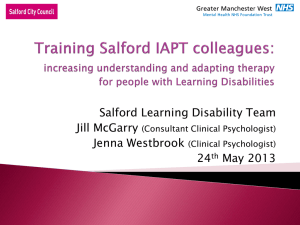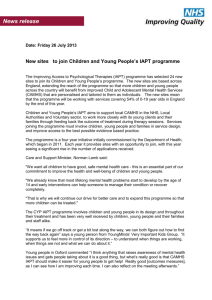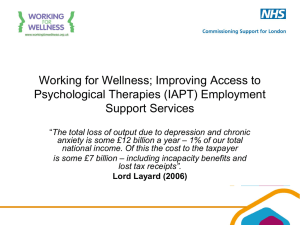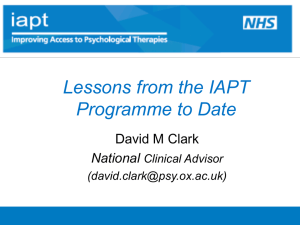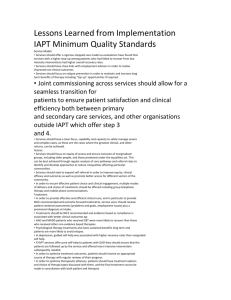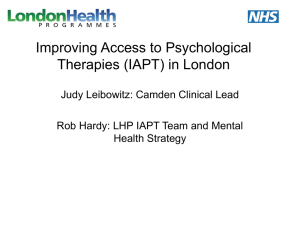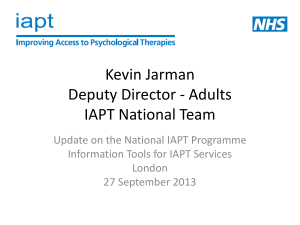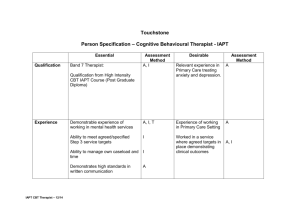Data collection in IAPT: Training presentation
advertisement
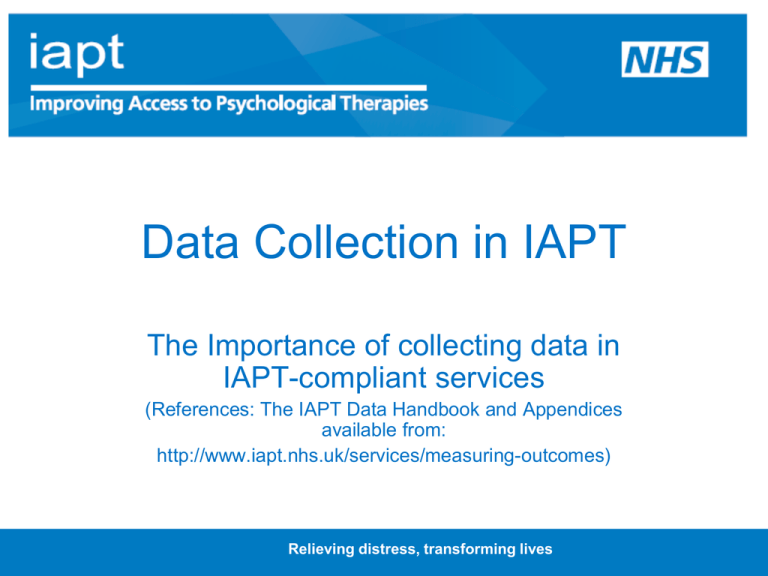
Data Collection in IAPT The Importance of collecting data in IAPT-compliant services (References: The IAPT Data Handbook and Appendices available from: http://www.iapt.nhs.uk/services/measuring-outcomes) Relieving distress, transforming lives Clinical Outcome Measurement • • • • • Rare in mental health Great resistance from practitioners Seen as fitting one clinical model only Time consuming? Interferes with patient therapist relationship? Wrong, wrong, wrong! Patient-reported Outcome Measures (PROMS) To enable: • Clinical governance • Case Supervision • Effective communication with patients • Patient involvement in decision making • Effective inter-professional communication Central Principles for data collection in IAPT • At each and every contact • Data used by patients and IAPT workers • Provides tangible evidence of treatment progression • Used by supervisors to review clinical work • Used by managers to facilitate effective service performance • Used by commissioners & others Ensuring Equality and Equity of Access • Equality Act 2010 • Services are legally required to recognise the diverse needs of individuals in the community • Must collect and analyse information of the different experiences of individuals • Collect information by age, ethnicity, faith, gender, diagnosis and sexuality • Links between physical and mental health • Used for health needs assessments Clinical Functions of Data Collection • Work collaboratively with patients at the outset and throughout a treatment episode • Use a combination of patient-centred interviewing and outcome measurement tools • Agree with patients the best treatments for their difficulties • Review continuing appropriateness of chosen treatment • Identify therapy targets • Manage the therapy process What do Patients Think? • ‘It was easy to understand, not too technical’ • ‘For quite a long time they [the scores] stayed the same and then they started dropping slowly and that was a big boost’ • ‘He [the case manager] would go through the questions. And I knew that I was getting better, just through the answers I was giving’ Simpson et al (2008) Mental Health in Family Medicine What do Patients Think? • ‘It made you realise if you were having a good week or a bad week. What you had managed to do or how I was actually feeling’ • ‘I seemed to improve every time we filled that in, so that was encouraging as well’ • ‘It was like a goal to try to bring it down’ Simpson et al (2008) Mental Health in Family Medicine What do Workers Think? • I liked it, [the PHQ9] I liked to use it every session. I didn’t find it difficult at all. And clients, even if they hadn’t the piece of paper with them at certain times, it was ok…. • I liked the simplicity of the PHQ9, it was quite simple, compared with [another widely used measure] and that was really, really good Richards et al (2006) Critical importance of sessional outcome data collection • Recording accurately, regularly and frequently improves the effectiveness of the stepped care model • Ensure data available for >90% of all contacts • Minimise missing data • Use IAPT Clinical Record to improve patient experience and benefits from the service • Improve the quality of clinical interventions • Aggregate outcomes data to define best practice What do Workers Think? It was good practice to get into it (PHQ9, etc) every single time we saw a patient. It was something that did not get skimped on. I’d think, I’ve got forty minutes with you and you’ve got a whole load of stuff to tell me, ……. I’ll just not do that questionnaire...……. But it’s better to get it done …….. at the beginning, because you always find things to use the last five minutes of your time.……….sometimes it also highlights things to talk about. Richards et al (2006) Structure of IAPT Data Standard Use fields in the IAPT Data Standard to collect: • Patient details e.g. Age, faith, gender, ethnicity, employment status, sexuality • Disability details, e.g. Co-morbid physical or mental health disability information • Referral data e.g. ‘Provisional diagnosis’, to inform the clinical approach, and key dates • Appointment data e.g. Outcome scores including anxiety disorder specific measures and key dates to measure recovery rates • Complete all required fields Remember • ALL patients should complete measures and IAPT workers should ensure they are accurately recorded in information systems • Measures should be taken at EVERY contact Implementation Messages • Make data collection integral to the management of patient pathways • Use data as a clinical management tool not as a management ‘bolt-on’ • Do not add to measurement burden unnecessarily And Finally…. • The IAPT Data Handbook contains detailed information on the value and importance of IAPT Data collection. Measurement tools are contained in the separate appendices file • The documents are free to download from http://www.iapt.nhs.uk/services/measuringoutcomes Thank You!

